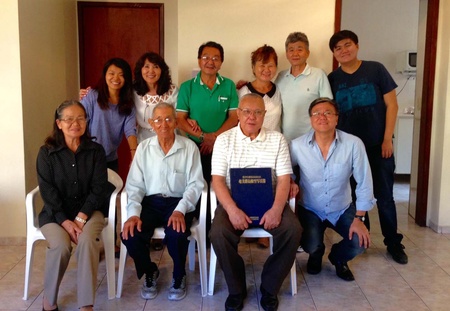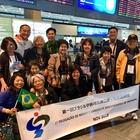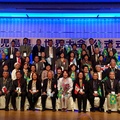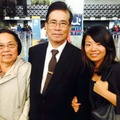Besides the Brajiru Bridge in Uken Village, Amami Oshima, there are other things that tell the history of Brazilian Amami immigrants. The Amami Hall, built in 1955 by people from Amami living in São Paulo, was unfortunately transferred to another Japanese organization in 2002, but the word "AMAMI" still remains in its name. The word "AMANI" can also be seen on the sign of a fish shop in the São Paulo Municipal Market. The fish shop is run by Shigehiro Tamari (76) (from Uken Village) and his sons.
"I came to Brazil when I was 15 with my uncle. But I also wanted to go, so I kind of came of my own volition," Shigehiro said. After graduating from junior high school, he worked as a delivery man and errand boy at a large store in Naze City, Amami Oshima, for three months before going to Brazil. His boss told him, "If you keep working like this, I'll let you go to high school," and he wavered, but he had already decided to go to Brazil, so he turned it down. At the time, he had no knowledge or information about Brazil, but he just thought, "I just want to go, I want to go." His classmates who left their hometowns headed for the mainland, such as Tokyo or Osaka, but Shigehiro could only see the land of Brazil.
After arriving in Brazil, he faced hardships like other immigrants. However, he says, "I really wanted to come here, so I've never regretted it since." When he was in his 20s, he worked for a fishing company. He soon became independent, buying fish himself and selling them by horse-drawn cart. He worked hard at business with his wife, mother-in-law, and children, all of whom are from the same hometown. He set up shop in the municipal market and expanded the business smoothly. He valued the relationship of trust with customers above all else. Now, his shop has become so well-known in Brazil's Japanese community that Japanese expatriates say, "This is the place where I can buy sashimi in peace."
Shigehiro always talks to his grandson Makoto (18), born in Brazil, about his hometown Amami, showing him the "Amami Islands Aerial Photo Collection." Makoto has been learning Japanese since he was a child, saying that when he becomes a university student, he wants to study in Japan and "go and see what Amami, where my grandpa and grandma were born and raised, is like."

The third and fourth generation of Brazilian immigrants to Amami are already here. The day will soon come when children with roots in Amami like him will come to Amami to see their grandparents' hometown. When that happens, will we tell them that Japanese immigrants to Brazil were "abandoned people"? Indeed, the stories of Brazilian immigrants include tales of hardships that far exceed imagination. There are also times when the immigrants themselves say "we are abandoned people" with a hint of self-deprecation. But is it right for us to sum up their history in one word: "abandoned people"?
Immigrants have colored the history of Brazil, a multi-ethnic nation. Samba, which represents Brazilian culture, was born from people who went to Brazil as a labor force after the abolition of slavery. "Even if we have nothing, we have samba," they said, blowing away the hardships of life by singing and dancing. This passion to live is what gives Brazil its cheerfulness. Even in such a country, there are people who still connect Amami.
This year (2018) marks the 100th anniversary of the Japanese immigration to Amami, Brazil, and also the 110th anniversary of Japanese immigration to Brazil. Various events are planned in both Japan and Brazil, so we will likely see more articles related to Japanese immigration to Brazil in the future. On this occasion, we, the people who sent immigrants to Brazil, would like to think again about what it was like to be Japanese immigrants to Brazil.
* * * * *
I hope this series will be an opportunity to learn about Brazil, which has a deep connection with Amami. A high school student who is interested in foreign countries came to the "Amami Brazil Immigration Discussion Meeting" that I held in Amami in February. "After seeing the exhibition, I learned that 'Amami' has been on the other side of the earth for 100 years, and it made me want to see more of Brazil and the world," he said.
Amami is connected to the world. Learn about the history of the people who have connected Amami in Brazil for 100 years, and think as an Amami native about how we should shape the next 100 years of Amami's history as it spreads to the world.
*This article is reprinted from the Nankai Nichinichi Shimbun (May 24, 2018).
© 2018 Saori Kato












